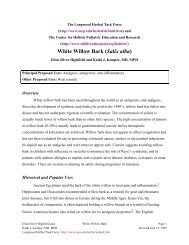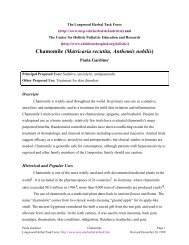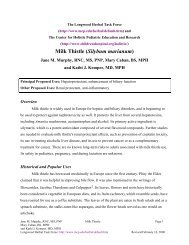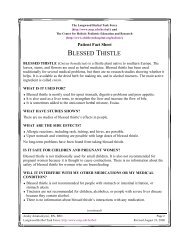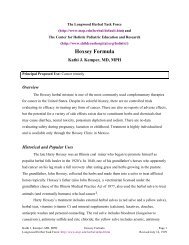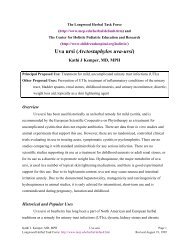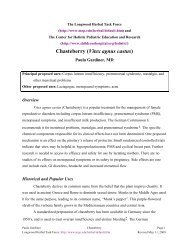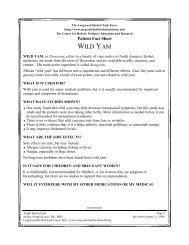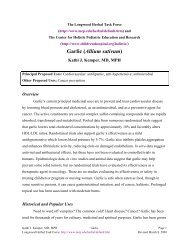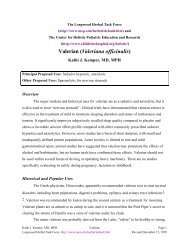Devil's Claw (Harpagophytum procumbens) - Longwood Herbal ...
Devil's Claw (Harpagophytum procumbens) - Longwood Herbal ...
Devil's Claw (Harpagophytum procumbens) - Longwood Herbal ...
Create successful ePaper yourself
Turn your PDF publications into a flip-book with our unique Google optimized e-Paper software.
The <strong>Longwood</strong> <strong>Herbal</strong> Task Force<br />
(http://www.mcp.edu/herbal/default.htm) and<br />
The Center for Holistic Pediatric Education and Research<br />
(http://www.childrenshospital.org/holistic/)<br />
Devil’s <strong>Claw</strong> (<strong>Harpagophytum</strong> <strong>procumbens</strong>)<br />
Kathi J. Kemper, MD, MPH<br />
Principal Proposed Use: Anti-inflammatory for degenerative or rheumatic joint disease and<br />
tendonitis<br />
Other Proposed Uses: Analgesic for other pains (headache, menstrual pain), antipyretic,<br />
Overview<br />
antidiabetic, appetite stimulant and bitter tonic, liver and gall bladder tonic, vulnerary<br />
The major clinical uses for Devil’s claw are for pain relief in joint diseases, back pain and<br />
headache. The evidence from scientific studies in animals and humans has resulted in widespread<br />
use of standardized Devil’s claw as a mild analgesic for joint pain in Europe. There are no<br />
studies evaluating its effectiveness as an appetite stimulant or liver tonic, but it is widely used for<br />
these purposes. The major potential risks and side effects include possible allergies and potential<br />
inotropic, chronotropic, antiarrhythmic and hypotensive effects; it is traditionally contraindicated<br />
for patients with gastric and duodenal ulcers, but side effects are rarely reported and tend to be<br />
limited to mild gastrointestinal upset. Commercial products are occasionally contaminated with<br />
inactive plants and other bitter African plants such as Elephantorrhiza and Acanthosicyos. There<br />
are no studies evaluating its safety or effectiveness during pregnancy, lactation, or childhood.<br />
Historical and Popular Uses<br />
Devil’s claw is a native of Southern Africa. It has long been used as a tea by indigenous<br />
peoples to treat gastrointestinal disorders and rheumatic conditions. A German farmer who had<br />
settled in the area exported the plant to Europe where it also became popular among British,<br />
European and Canadian herbalists for the supportive treatment of degenerative or rheumatic joint<br />
disease, tendonitis and other pains (headache, backache, menstrual pain) 1 , 2 , 3 , 4 , 5 . It is also used<br />
Kathi J. Kemper, MD, MPH Devil’s <strong>Claw</strong> Page 1<br />
<strong>Longwood</strong> <strong>Herbal</strong> Task Force: http://www.mcp.edu/herbal/default.htm Revised July 29, 1999
as an antipyretic, appetite stimulant and bitter tonic, for conditions of the liver, gall bladder and<br />
urinary tract, and to treat allergies. An ointment containing Devil’s claw root is used as a<br />
vulnerary (to treat skin injuries and disorders).<br />
Botany<br />
Medicinal species: <strong>Harpagophytum</strong> <strong>procumbens</strong> DC and H. zeheri 6<br />
Common names: Devil’s claw, grapple plant, wood spider, Teufelskralle (German),<br />
Trampelklette (German), griffe du diable (French).<br />
Botanical family: Pedaliaceae<br />
Plant description: The name derives from the fruits of the perennial plant, which appear to be<br />
covered with small hooks. The fruits are 7-20 centimeters long and 6 cm in diameter;<br />
they contain approximately 50 dark seeds. The flowers are large, pale-pink to red. The<br />
part used medicinally is the dried tubular and secondary roots and the macerated thick<br />
lateral tubers, which are cut into slices and dried.<br />
Where it’s grown: Devil’s claw is native to the red sand areas in the Transvaal of South Africa<br />
and Namibia. It has spread throughout the Kalahari and Savannah desert regions.<br />
American products are imported from Africa.<br />
Biochemistry<br />
Devils <strong>Claw</strong>: Potentially Active Chemical Constituents<br />
• Iridoid glycosides (2.2% total weight) 7 :<br />
Harpagosides (very bitter flavor): 0.5 –1.6% (minimum of 1.2% in European<br />
standardized products) 8<br />
8-p-coumaroyl harpagide 9<br />
Procumbide and procumboside<br />
• Phenols: acetoside (verbascoside), isoacetoside 10<br />
• Other: harpagoquinones, amino acids, flavonoids, phytosterols, carbohydrates 11<br />
Harpagoside has a very bitter flavor which may make some products unpalatable. The<br />
iridoid glycosides have dose-dependent anti-inflammatory and analgesic effects equivalent to<br />
Kathi J. Kemper, MD, MPH Devil’s <strong>Claw</strong> Page 2<br />
<strong>Longwood</strong> <strong>Herbal</strong> Task Force: http://www.mcp.edu/herbal/default.htm Revised July 29, 1999
phenylbutazone; they are apparently inactivated by gastric acids 12 . Harpagoside is most effective<br />
when given parenterally, and loses potency markedly when given by mouth; enteric coated<br />
preparations might maintain efficacy despite exposure to gastric acids 13 . Harpagoside inhibits<br />
arachidonic acid metabolism through both cyclo-oxygenase and lipoxygenase pathways. The<br />
harpagoside content varies within the plant, and is highest in the secondary tubers, with lower<br />
levels in the primary roots. The flowers, stems and leaves appear to be devoid of active<br />
compounds.<br />
Experimental Studies<br />
1. Cardiovascular: Antiarrhythmic<br />
2. Pulmonary: none<br />
3. Renal and electrolyte balance: none<br />
Devil’s <strong>Claw</strong>: Potential Clinical Benefits<br />
4. Gastrointestinal/hepatic: Appetite stimulant, digestive tonic, liver and gall bladder tonic<br />
5. Neuro-psychiatric: Analgesic: see Immune modulation<br />
6. Endocrine: Antidiabetic<br />
7. Hematologic: none<br />
8. Rheumatologic: Degenerative joint disease: see Immune modulation<br />
9. Reproductive: none<br />
10. Immune modulation: Anti-inflammatory<br />
11. Antimicrobial: none<br />
12. Antineoplastic: none<br />
13. Antioxidant: none<br />
14. Skin and mucus membranes: Vulnerary (wound healing)<br />
15. Other/miscellaneous: none<br />
1. Cardiovascular: Antiarrhythmic: This is not a traditional use of Devil’s claw.<br />
i. In vitro data: In isolated rat hearts, Devil’s claw extracts had a dose-dependent protective<br />
effect against arrhythmias induced by reperfusion 14 ; similar protective effects were<br />
found in isolated rabbit hearts subjected to arrhythmogenic chemicals 14 , 15 .<br />
Kathi J. Kemper, MD, MPH Devil’s <strong>Claw</strong> Page 3<br />
<strong>Longwood</strong> <strong>Herbal</strong> Task Force: http://www.mcp.edu/herbal/default.htm Revised July 29, 1999
ii. Animal data: In low doses, Devil’s claw extracts had mildly negative chronotropic effects<br />
and positive inotropic effects 16 , 17 ; high doses caused a marked negative inotropic effect<br />
and reduced coronary blood flow 14 . In normotensive rats, intraperitoneal injections of<br />
Devil’s claw had mild hypotensive effects as well as antiarrhythmic effects 15 .<br />
iii. Human data: none<br />
2. Pulmonary: none<br />
3. Renal and electrolyte balance: none<br />
4. Gastrointestinal/hepatic: Appetite stimulant, digestive tonic, liver and gall bladder tonic<br />
a. Appetite stimulant: No randomized trials have evaluated this use.<br />
b. Digestive tonic<br />
i. In vitro data: In isolated guinea pig jejunum, Devil’s claw extracts decreased the<br />
contractile response of smooth muscle to acetylcholine 16 ; in guinea pig ileum,<br />
harpagoside nonselectively inhibited contractions induced by various chemical<br />
agonists 18 .<br />
ii. Animal data: none<br />
iii. Human data: In an adult case series, oral administration of Devil’s claw (1 tsp in 2<br />
cups of water) resulted in improvements in constipation, diarrhea, appetite and<br />
flatulence 19 .<br />
c. Liver and gall bladder tonic: No randomized trials have evaluated this use.<br />
5. Neuro-psychiatric: Analgesic: See Immune modulation<br />
6. Endocrine: Antidiabetic: Traditional use; no data.<br />
7. Hematologic: none<br />
8. Rheumatologic: Degenerative joint disease 20 : See Immune modulation<br />
9. Reproductive: none<br />
10. Immune modulation: Anti-inflammatory<br />
i. In vitro data: Devil’s claw (100 mg/ ml) had no significant impact on prostaglandin<br />
synthesis 21 .<br />
ii. Animal data: In several studies in rats, mice and guinea pigs, harpagoside reduced<br />
experimentally-induced inflammation 22 , 23 , 24 , 25 , 26 . In one study, the effects of 20<br />
mg/kg/day of Devil’s claw were comparable to 40 mg/kg/day of phenylbutazone 25 .<br />
Kathi J. Kemper, MD, MPH Devil’s <strong>Claw</strong> Page 4<br />
<strong>Longwood</strong> <strong>Herbal</strong> Task Force: http://www.mcp.edu/herbal/default.htm Revised July 29, 1999
However, Devil’s claw extracts were not as effective as indomethacin, nor were they as<br />
effective when given by mouth as when given by injection, apparently due to inactivation<br />
by gastric acids 12 , 21 , 27 , 28 , 29 .<br />
iii. Human data: In normal volunteers, three weeks of daily treatment with 2 grams of<br />
standardized Devil’s claw extract had no impact on levels of prostaglandin E2,<br />
thromboxane B2, leukotriene B4, or 6-ketoprostaglandin F 30 . In 13 arthritic patients<br />
treated for 13 weeks with Devil’s claw tablets (410 mg TID) there were no significant<br />
improvements 28 . In an open trial in 630 adults with joint pain, six months of treatment<br />
with Devil’s claw extract in daily dosages of 1 – 3 gms TID resulted in pain relief in 42%<br />
- 85% (depending on site of pain); the only adverse effect was mild stomach upset even<br />
with the highest doses 3 .<br />
In a double blind study of adults with joint pain, treatment with 770 mg TID of a<br />
standardized Devil’s <strong>Claw</strong> extract resulted in significant improvement in pain and<br />
flexibility over two months; no side effects were reported 4 , 31 . In two separate<br />
randomized, double blind, placebo controlled trials of adults suffering from chronic low<br />
back pain, Devil’s claw treatment provided significant improvement in pain scores within<br />
four weeks 32 , 33 .<br />
11. Antimicrobial: none<br />
12. Antineoplastic: none<br />
13. Antioxidant: none<br />
14. Skin and mucus membranes: Vulnerary (wound healing): Traditional use; no data.<br />
15. Other/miscellaneous: none<br />
Kathi J. Kemper, MD, MPH Devil’s <strong>Claw</strong> Page 5<br />
<strong>Longwood</strong> <strong>Herbal</strong> Task Force: http://www.mcp.edu/herbal/default.htm Revised July 29, 1999
Toxicity and Contraindications<br />
All herbal products carry the potential for contamination with other herbal products, pesticides,<br />
herbicides, heavy metals, and pharmaceuticals.<br />
This is particularly concerning with imports from developing countries.<br />
Allergic reactions can occur to any natural product in sensitive persons.<br />
Allergic reactions have not been reported.<br />
Potentially toxic compounds in Devil’s claw: Unknown. Devil’s claw is occasionally adulterated<br />
with harpagoside-poor primary roots or with other bitter African plants such as<br />
Elephantorrhiza and Acanthosicyos.<br />
Acute toxicity: In a trial of Devil’s claw as a treatment for arthritis, one patient withdrew after<br />
four days of therapy due to early morning headache, tinnitus, anorexia and loss of taste 28 .<br />
Mild gastrointestinal upset has been reported in sensitive individuals, especially at higher<br />
dosages. The LD 50 in mice is greater than 13.5 grams per kg of body weight 21 , 23 , 34 .<br />
Because of the lack of effect on the biosynthesis of prostanoids, the adverse effects<br />
usually expected with non-steroidal anti-inflammatories and glucocorticoid medications<br />
are not expected with Devil’s claw 30 , 35 .<br />
Chronic toxicity: None in rat studies<br />
Limitations during other illnesses or in patients with specific organ dysfunction: Devil’s claw is<br />
traditionally contraindicated in patients with gastric or duodenal ulcers due to presumed<br />
stimulation of gastric acid secretion; no studies have evaluated this possibility. Because<br />
of its stimulant effects on the gall bladder, herbalists recommend that patients with<br />
gallstones use Devil’s claw only in consultation with a physician. Traditionally, Devil’s<br />
claw is contraindicated in diabetes, but no data support this assertion. In light of its<br />
potential antiarrhythmic effects, potential interactions with antiarrhythmic drugs cannot<br />
be excluded.<br />
Interactions with other herbs or pharmaceuticals: None reported<br />
Safety during pregnancy, lactation and/or childhood: Devil’s claw is thought to be oxytocic and<br />
therefore to be avoided in pregnancy 25 ; however, there are no data to support this<br />
recommendation, and no data on Devil’s claw’s safety or efficacy during pregnancy,<br />
lactation, or childhood.<br />
Kathi J. Kemper, MD, MPH Devil’s <strong>Claw</strong> Page 6<br />
<strong>Longwood</strong> <strong>Herbal</strong> Task Force: http://www.mcp.edu/herbal/default.htm Revised July 29, 1999
Typical Dosages<br />
Provision of dosage information does NOT constitute a recommendation or endorsement, but<br />
rather indicates the range of doses commonly used in herbal practice.<br />
Doses are given for single herb use and must be adjusted when using herbs in combinations.<br />
Doses may also vary according to the type and severity of the condition treated and individual<br />
Adult doses 36 :<br />
Dried root:<br />
patient conditions.<br />
For pain relief: 3.0 - 4.5 grams of dried root mixed in boiling water, steeped eight<br />
hours and taken po TID<br />
For appetite loss: 0.5 - 1.5 grams of dried root, mixed in boiling water, steeped<br />
eight hours and taken po TID<br />
Tincture: (1:5 in 25% alcohol): 0.5 – 1.0 ml TID 25<br />
(1:10 in 25% alcohol): 3 ml TID 37<br />
Liquid extract: (1:1 in 25% alcohol): 0.1 – 0.25 ml TID 25<br />
Pediatric dosages: Unknown<br />
Availability of standardized preparations: A German analysis of several commercial products<br />
showed variation of harpagoside content from 0.5 to 9.3 mg per tablet, resulting in daily<br />
doses of 1.5 to 50 mg 38 , 39 . Standardized extracts are available; these should be used<br />
whenever possible to ensure adequate dosing.<br />
Dosages used in herbal combinations: Variable<br />
Proprietary names: Algophytum, Arthrosetten H, Arthrotabsm, Artigel, Defencid, Devil’s <strong>Claw</strong><br />
Secondary Root, Doloteffin, Fitokey <strong>Harpagophytum</strong>, Harpadol, Hariosen, Jucurba N,<br />
Rheuma-Sern, Rheuma-Tee, HarpagoMega, Salus<br />
Multi-ingredient preparations containing Devil’s claw root: Arktophytum, Arthritic Pain <strong>Herbal</strong><br />
Formula, Devil’s <strong>Claw</strong> Plus, Lifesystem <strong>Herbal</strong> Formula 1 Arthritic Aid, Lifesystem<br />
<strong>Herbal</strong> Formula 12 Willowbark, Prost-1, Green Lipped Mussel (FM), <strong>Harpagophytum</strong><br />
Formula.<br />
Kathi J. Kemper, MD, MPH Devil’s <strong>Claw</strong> Page 7<br />
<strong>Longwood</strong> <strong>Herbal</strong> Task Force: http://www.mcp.edu/herbal/default.htm Revised July 29, 1999
See Also:<br />
<strong>Devil's</strong> <strong>Claw</strong> Clinician Information Summary:<br />
http://www.mcp.edu/herbal/devilsclaw/devilsclaw.cis.pdf<br />
<strong>Devil's</strong> <strong>Claw</strong> Patient Fact Sheet:<br />
http://www.mcp.edu/herbal/devilsclaw/devilsclaw.ph.pdf<br />
Kathi J. Kemper, MD, MPH Devil’s <strong>Claw</strong> Page 8<br />
<strong>Longwood</strong> <strong>Herbal</strong> Task Force: http://www.mcp.edu/herbal/default.htm Revised July 29, 1999
REFERENCES<br />
1. Barnes J, Ernst E. Traditional herbalists' prescriptions for common clinical conditions: A survey of<br />
members of the UK National Institute for Medical <strong>Herbal</strong>ists. Phytotherapy Research 1998; 12:369-71.<br />
2. Caprasse M. Description, identification and therapeutical uses of the "devil's claw": <strong>Harpagophytum</strong><br />
<strong>procumbens</strong> DC. Journal de Pharmacie de Belgique 1980; 35:143-9.<br />
3. Belaiche P. Etude clinique de 630 cas d'artrose traites par le nebulisat aqueux d'<strong>Harpagophytum</strong><br />
<strong>procumbens</strong> (Radix). Phytotherapy 1982; 1:22-28.<br />
4. Lecomte A, Costa J. <strong>Harpagophytum</strong> dans l'arthrose: Etude en double insu contre placebo. 37 2 Le<br />
Magazine 1992; 15:27-30.<br />
5. Chrubasik S, Wink M. Traditional herbal therapy for the treatment of rheumatic pain: Preparations from<br />
devil's claw and stinging nettle. Pain Digest 1998; 8:94-101.<br />
6. Baghdikian B, Lanhers MC, Fleurentin J, et al. An analytical study, anti-inflammatory and analgesic effects<br />
of <strong>Harpagophytum</strong> <strong>procumbens</strong> and <strong>Harpagophytum</strong> zeyheri. Planta Medica 1997; 63:171-6.<br />
7. Kikuchi T. New iridoid glucosides from <strong>Harpagophytum</strong> <strong>procumbens</strong>. Chem Pharm Bull 1983; 31:2296-<br />
2301.<br />
8. Haag-Berrurier M, Kuballa B, Anton R. Dosage des glucoiridoides totaux dans la racine d'<strong>Harpagophytum</strong><br />
<strong>procumbens</strong> DC und <strong>Harpagophytum</strong> zeheri DECNE. Plant Medica 1978; 12:197-206.<br />
9. Czygan FC, Kruger A, Schier W, Volk O. Pharmaceutical-biological analysis of the family <strong>Harpagophytum</strong><br />
(Bruch.) DC ex Meissn. Part 1. Deutsche APtheker Zeitung 1977; 117:1431-34.<br />
10. Burger J. Iridoid and phenolic glycosides from <strong>Harpagophytum</strong> <strong>procumbens</strong>. Phytochemistry 1987;<br />
26:1453-7.<br />
11. Ziller K, Franz G. Analysis of the water-soluble fraction from the roots of harpagophytum <strong>procumbens</strong>.<br />
Planta Med 1979; 37:340-8.<br />
12. Soulimani R, Younos C, Mortier F, Derrieu C. The role of stomachal digestion on the pharmacological<br />
activity of plant extracts, using as an example extracts of <strong>Harpagophytum</strong> <strong>procumbens</strong>. Canadian Journal<br />
of Physiology & Pharmacology 1994; 72:1532-6.<br />
13. Duke JA. Green Pharmacy. Emmaus, PA: Rodale Press, 1997:507.<br />
14. Costa De Pasquale R, Busa G, Circosta C, et al. A drug used in traditional medicine: <strong>Harpagophytum</strong><br />
<strong>procumbens</strong> DC. III. Effects on hyperkinetic ventricular arrhythmias by reperfusion. Journal of<br />
Ethnopharmacology 1985; 13:193-9.<br />
15. Circosta C, Occhiuto F, Ragusa S, et al. A drug used in traditional medicine: <strong>Harpagophytum</strong> <strong>procumbens</strong><br />
DC. II. Cardiovascular activity. Journal of Ethnopharmacology 1984; 11:259-74.<br />
16. Occhiuto F, Circosta C, Ragusa S, Ficarra P, Costa De Pasquale R. A drug used in traditional medicine:<br />
<strong>Harpagophytum</strong> <strong>procumbens</strong> DC. IV. Effects on some isolated muscle preparations. Journal of<br />
Ethnopharmacology 1985; 13:201-8.<br />
Kathi J. Kemper, MD, MPH Devil’s <strong>Claw</strong> Page 9<br />
<strong>Longwood</strong> <strong>Herbal</strong> Task Force: http://www.mcp.edu/herbal/default.htm Revised July 29, 1999
17. Occhiuto F, De Pasquale A. Electrophysiological and haemodynamic effects of some active principles of<br />
<strong>Harpagophytum</strong> <strong>procumbens</strong> DC. in the dog. Pharmacological Research 1990; 22:72-3.<br />
18. Fontaine J, Elchami AA, Vanhaelen M, Vanhaelen-Fastre R. Biological analysis of <strong>Harpagophytum</strong><br />
<strong>procumbens</strong> D.C. II. Pharmacological analysis of the effects of harpagoside, harpagide and harpagogenine<br />
on the isolated guinea-pig ileum. Journal de Pharmacie de Belgique 1981; 36:321-4.<br />
19. Zimmerman W. Pflanzliche Bitterstoffe in der Gastroenterologie. Z. Allgemeinmed 1976; 54:1178-84.<br />
20. Wenzel P, Wegener T. Harpagophtum <strong>procumbens</strong> -- A plant antirheumatic agent. Deutsche Apotheker<br />
Zeitung 1995; 135:15-28.<br />
21. Whitehouse LW, Znamirowska M, Paul CJ. <strong>Devil's</strong> <strong>Claw</strong> (<strong>Harpagophytum</strong> <strong>procumbens</strong>): no evidence for<br />
anti-inflammatory activity in the treatment of arthritic disease. Canadian Medical Association Journal 1983;<br />
129:249-51.<br />
22. Eichler O, Koch C. Antiphlogistic, analgesic and spasmolytic effect of harpagoside, a glycoside from the<br />
root of <strong>Harpagophytum</strong> <strong>procumbens</strong> DC. Arzneimittel-Forschung 1970; 20:107-9.<br />
23. Erdos A, Fontaine R, Friehe H, Durand R, Poppinghaus T. Contribution to the pharmacology and<br />
toxicology of different extracts as well as the harpagosid from <strong>Harpagophytum</strong> <strong>procumbens</strong> DC. Planta<br />
Medica 1978; 34:97-108.<br />
24. Lanhers MC, Fleurentin J, Mortier F, Vinche A, Younos C. Anti-inflammatory and analgesic effects of an<br />
aqueous extract of <strong>Harpagophytum</strong> <strong>procumbens</strong>. Planta Medica 1992; 58:117-23.<br />
25. Newall CA, Anderson LA, Phillipson JD. <strong>Herbal</strong> Medicines: A guide for Health-care Professionals.<br />
London: The Pharmaceutical Press, 1996:296.<br />
26. Jadot G, Lecomte A. Activite anti-inflammatoire d'<strong>Harpagophytum</strong> <strong>procumbens</strong> DC. Lyon. Mediterraneee<br />
Medical Medecine du Sud-Est 1992; 28:833-5.<br />
27. McLeod DW, Revell P, Robinson BV. Investigations of <strong>Harpagophytum</strong> <strong>procumbens</strong> (<strong>Devil's</strong> <strong>Claw</strong>) in the<br />
treatment of experimental inflammation and arthritis in the rat [proceedings]. British Journal of<br />
Pharmacology 1979; 66:140P-141P.<br />
28. Grahame R, Robinson BV. Devils's claw (<strong>Harpagophytum</strong> <strong>procumbens</strong>): pharmacological and clinical<br />
studies [letter]. Annals of the Rheumatic Diseases 1981; 40:632.<br />
29. Recio M, Giner R, Manez S, Rios J. Structural considerations on the iridoids as anti-inflammatory agents.<br />
Planta Medica 1994; 60:232-4.<br />
30. Moussard C, Alber D, Toubin MM, Thevenon N, Henry JC. A drug used in traditional medicine,<br />
harpagophytum <strong>procumbens</strong>: no evidence for NSAID-like effect on whole blood eicosanoid production in<br />
human. Prostaglandins Leukotrienes & Essential Fatty Acids 1992; 46:283-6.<br />
31. Schulz V, Hansel R, Tyler VE. Rational Phytotherapy: A Physicians' Guide to <strong>Herbal</strong> Medicine. Berlin:<br />
Springer, 1997:306.<br />
32. Chrubasik S, Zimpfer C, Schutt U, Ziegler R. Effectiveness of <strong>Harpagophytum</strong> <strong>procumbens</strong> in treatment of<br />
acute low back pain. Phytomedicine 1996; 3:1-10.<br />
Kathi J. Kemper, MD, MPH Devil’s <strong>Claw</strong> Page 10<br />
<strong>Longwood</strong> <strong>Herbal</strong> Task Force: http://www.mcp.edu/herbal/default.htm Revised July 29, 1999
33. Chrubasik S, Schmidt A, Junck H, Pfisterer M. Wirksamkeit und Wirtschaftlichkeit von<br />
Teufelskrallenwurzelextract bei Ruckenschmerzen: erste Ergebnisse einer Anwendungsbeobachtung.<br />
Forsch Komplementarmed 1997; 4.<br />
34. Vanhaelen M, Vanhaelen R, Samaey-Fontaine J, Elchamid A, Niebes P, Matagne D. Aspects botaniques,<br />
constitution chimique et activite pharacologique d'<strong>Harpagophytum</strong> <strong>procumbens</strong> DC. Phytotherapy 1983;<br />
5:7-13.<br />
35. Lowe D. <strong>Harpagophytum</strong> <strong>procumbens</strong> DC. Eine Ubersicht zur Pharmakologie und WIrksamkeit.<br />
Erfahrungsheilkunde 1995; 2:74-9.<br />
36. Abramaowitz M. Med Letter 1979; 21:30-?<br />
37. Anonymous. Harpagophyti radix. ESCOP Monographs. Elburg, 1996.<br />
38. Eich J, Schmidt M, Betti G. HPLC analysis of iridoid compounds of <strong>Harpagophytum</strong> taxa: Quality control<br />
of pharmaceutical drug material. Pharmaceutical and Pharmacological Letters 1998; 8:75-78.<br />
39. Mestdagh O, Torck M. Quality evaluation of Harpagophyton capsules. Annales Pharmaceutiques<br />
Francaises 1995; 53:135-7.<br />
Kathi J. Kemper, MD, MPH Devil’s <strong>Claw</strong> Page 11<br />
<strong>Longwood</strong> <strong>Herbal</strong> Task Force: http://www.mcp.edu/herbal/default.htm Revised July 29, 1999



